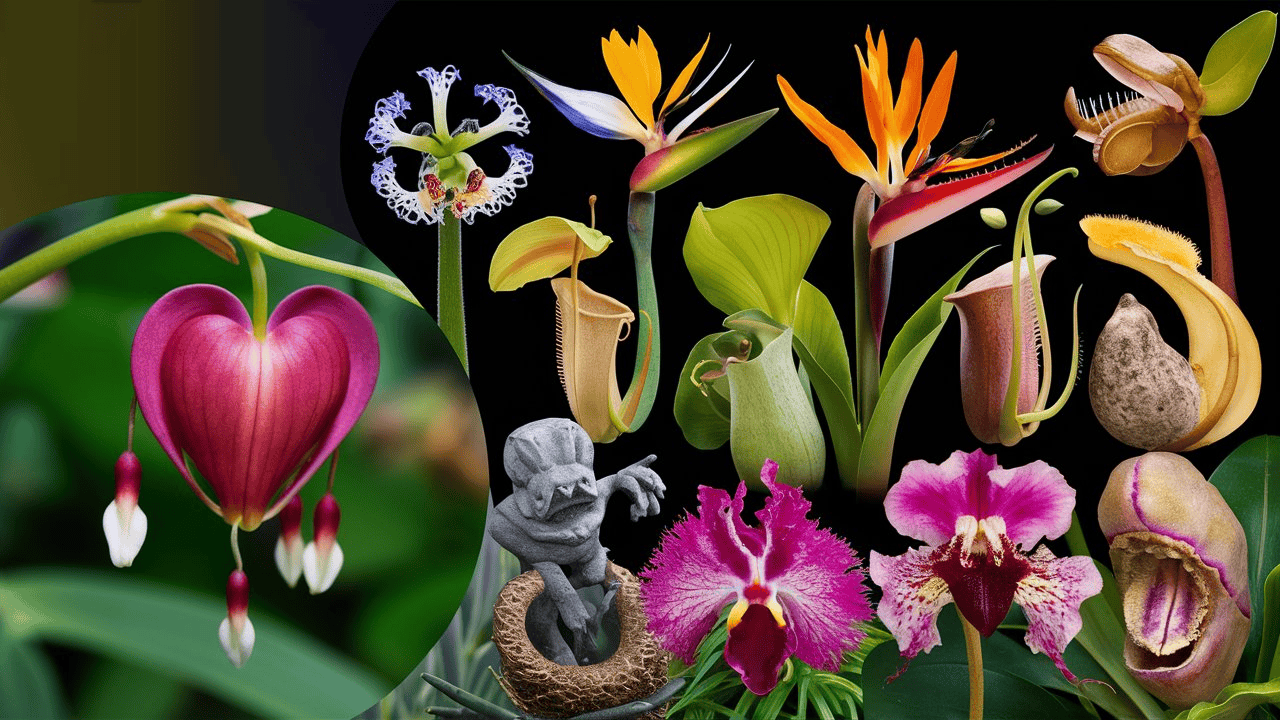In the vast and diverse realm of the plant kingdom, there exists a captivating array of species that defy the conventional notions of what a plant should look like. These unusual plants, with their striking features and intriguing characteristics, have the power to captivate and inspire us, revealing the boundless creativity of nature.
Duck Orchid (Caleana major)
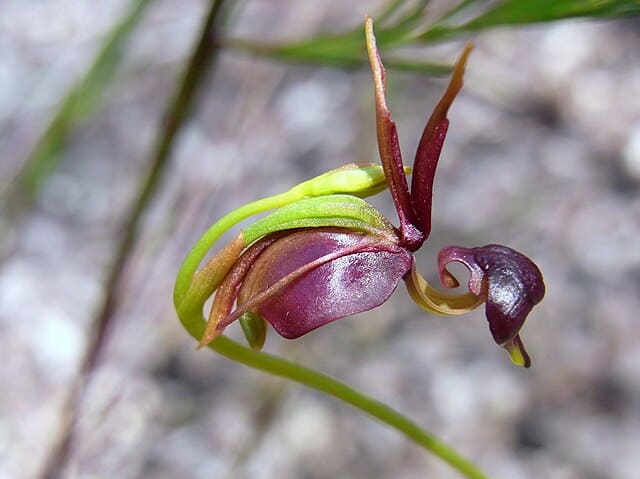
Nestled within the lush, Australian bushlands, the Duck Orchid (Caleana major) is a truly remarkable member of the orchid family. This unique plant, with its striking resemblance to a swimming duck, has captured the imagination of botanists and nature enthusiasts alike.
The Duck Orchid’s distinctive appearance is an evolutionary adaptation to attract its primary pollinator – the male sawfly. The flower’s intricate structure, complete with a “beak” and “wings,” mimics the female sawfly, luring the male insect in search of a mate. As the unsuspecting sawfly attempts to “mate” with the flower, it inadvertently picks up the orchid’s pollen, ensuring cross-pollination.
This ingenious pollination strategy is just one of the many fascinating aspects of the Duck Orchid. The plant’s resilience and adaptability to its harsh, Australian environment are also noteworthy, as it thrives in areas with poor soil and limited water resources.
Naked Man Orchid (Orchis italica)
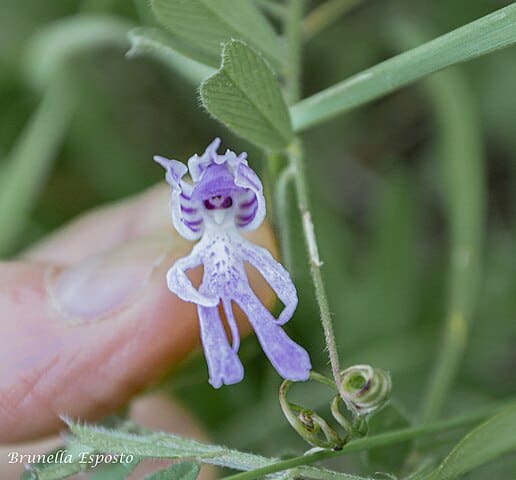
Hailing from the Mediterranean region, the Naked Man Orchid (Orchis italica) is a captivating member of the orchid family that has long been the subject of fascination and intrigue. With its uncanny resemblance to a human figure, this orchid’s unique appearance has inspired countless legends and folklore throughout history.
The Naked Man Orchid’s distinctive shape is the result of its floral structure, which features a central “body” surrounded by “arms” and “legs.” This striking visual effect is believed to be an adaptation to attract specific pollinators, such as bees and flies, which are drawn to the flower’s nectar-rich blooms.
Beyond its visual appeal, the Naked Man Orchid has also been the subject of numerous cultural and medicinal traditions. In some regions, the plant’s tubers have been used in traditional remedies, while its symbolic significance has been woven into the fabric of local folklore and mythology.
Monkey Orchid (Dracula simia)
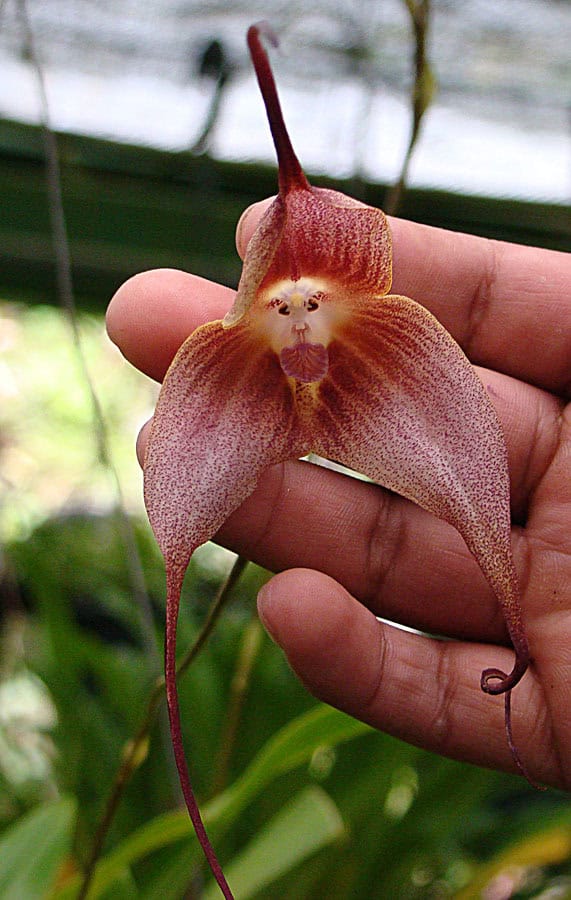
Deep within the cloud forests of Central and South America, the Monkey Orchid (Dracula simia) stands out as a true marvel of the plant kingdom. With its uncanny resemblance to a tiny, furry primate, this orchid has captivated the hearts and imaginations of botanists and nature enthusiasts worldwide.
The Monkey Orchid’s distinctive appearance is the result of its unique floral structure, which features a central “face” surrounded by “arms” and “legs.” This striking visual effect is believed to be an adaptation to attract specific pollinators, such as small flies and moths, which are drawn to the flower’s intricate details and nectar-rich blooms.
Beyond its visual appeal, the Monkey Orchid is also known for its resilience and adaptability. These orchids thrive in the cool, humid environments of their native cloud forests, where they cling to the trunks and branches of towering trees, creating a mesmerizing display of natural artistry.
Dove Orchid (Peristeria elata)

Hailing from the tropical regions of Central and South America, the Dove Orchid (Peristeria elata) is a captivating member of the orchid family that has long been the subject of fascination and reverence. With its striking resemblance to a graceful, descending dove, this orchid’s unique appearance has inspired countless legends and cultural traditions.
The Dove Orchid’s distinctive shape is the result of its intricate floral structure, which features a central “body” surrounded by “wings” and “tail feathers.” This striking visual effect is believed to be an adaptation to attract specific pollinators, such as bees and hummingbirds, which are drawn to the flower’s nectar-rich blooms.
Beyond its visual appeal, the Dove Orchid has also been the subject of numerous cultural and religious associations. In some regions, the plant has been revered as a symbol of peace, purity, and divine inspiration, with its image appearing in various artistic and spiritual traditions.
Globe Thistles (Echinops)
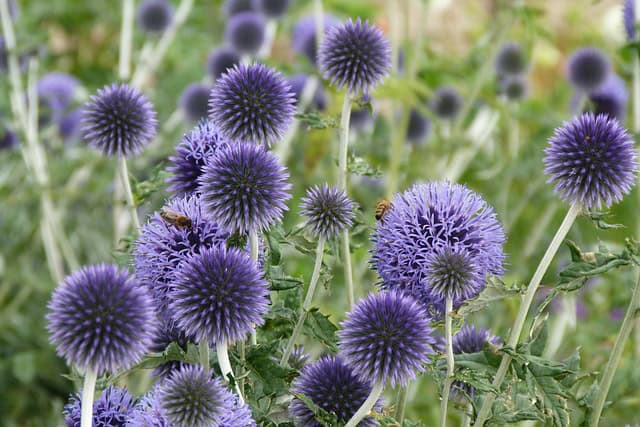
Amidst the vibrant tapestry of the garden, the Globe Thistles (Echinops) stand out as true botanical marvels. These striking perennials, with their spherical, spiny flower heads, have a captivating presence that commands attention and intrigue.
The Globe Thistle’s unique appearance is the result of its intricate floral structure, which features a dense arrangement of tiny, individual flowers clustered together to form a single, globular bloom. This distinctive shape serves a dual purpose – it not only creates a visually striking display, but it also helps to attract a variety of pollinators, including bees, butterflies, and even hummingbirds.
Beyond their aesthetic appeal, Globe Thistles are also prized for their resilience and adaptability. These plants thrive in a wide range of soil conditions and climates, making them a popular choice for gardeners and landscapers alike. Additionally, the plant’s spiny foliage and stems provide a natural defense against herbivores, ensuring its survival in the face of potential threats.
Purple Triple Datura (Datura metel)
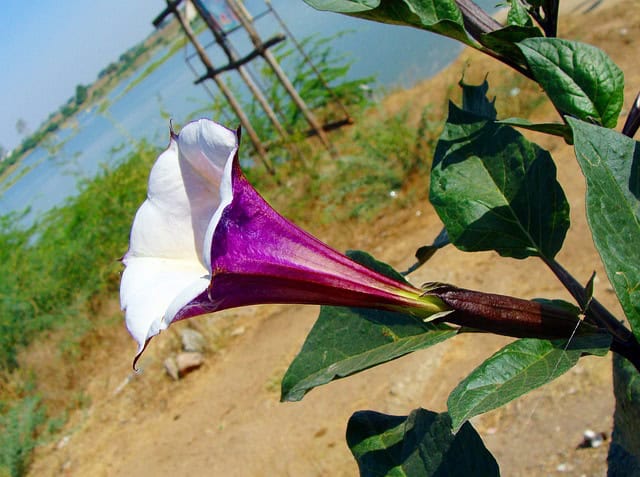
Hailing from the tropical and subtropical regions of the world, the Purple Triple Datura (Datura metel) is a captivating member of the nightshade family that has long been the subject of fascination and intrigue. With its striking, triple-layered flowers in shades of deep purple, this plant is a true standout in the garden.
The Purple Triple Datura’s unique appearance is the result of its intricate floral structure, which features a central, trumpet-shaped bloom surrounded by two additional layers of petals. This mesmerizing display is believed to be an adaptation to attract specific pollinators, such as moths and hummingbirds, which are drawn to the plant’s nectar-rich flowers.
Beyond its visual appeal, the Purple Triple Datura has also been the subject of numerous cultural and medicinal traditions. In some regions, the plant has been used in traditional remedies, while its psychoactive properties have been the subject of both fascination and caution throughout history.
Kissing Lips (Psychotria elata)

Deep within the lush, tropical forests of Central and South America, the Kissing Lips (Psychotria elata) stands out as a true botanical marvel. With its striking, red-lipped flowers that seem to pucker and “kiss,” this plant has captivated the hearts and imaginations of nature enthusiasts worldwide.
The Kissing Lips’ unique appearance is the result of its specialized floral structure, which features a central, red-colored bract that resembles a pair of pursed lips. This striking visual effect is believed to be an adaptation to attract specific pollinators, such as hummingbirds and butterflies, which are drawn to the plant’s nectar-rich blooms.
Beyond its captivating appearance, the Kissing Lips is also known for its ecological significance. These plants play a crucial role in the delicate balance of their tropical forest habitats, providing food and shelter for a variety of animal species, from insects to small mammals.
Bleeding Hearts (Dicentra)
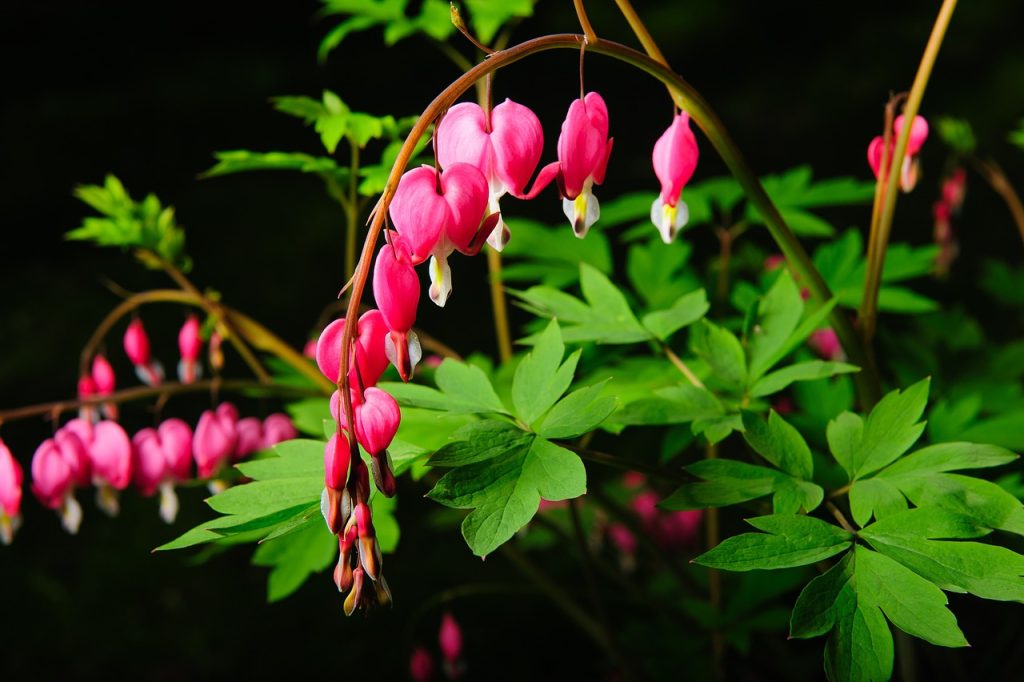
Emerging from the lush, shaded forest floors, the Bleeding Heart (Dicentra) is a delicate and enchanting perennial that commands attention with its unique heart-shaped flowers. These pendulous blooms, often in shades of pink or white, seem to “bleed” from the tips, creating a mesmerizing visual effect that has earned them their evocative name.
Beneath their ethereal appearance, Bleeding Hearts possess a fascinating biology. The flowers’ distinctive shape is an adaptation to attract specific pollinators, such as hummingbirds and bees, which are drawn to the nectar-rich blossoms. Additionally, the plant’s foliage, with its finely divided, fern-like leaves, adds to its overall charm and elegance.
Passion Flower (Passiflora)

Hailing from the tropical and subtropical regions of the Americas, the Passion Flower (Passiflora) is a captivating genus that boasts an array of species, each with its own unique charm. These vines, with their intricate and often vibrant flowers, have long been a source of fascination for botanists and nature enthusiasts alike.
The Passion Flower’s name is derived from the religious symbolism associated with its intricate floral structure, which is said to represent the Passion of Christ. The flowers’ elaborate petals, corona, and intricate details create a mesmerizing display that has inspired countless artists and poets throughout history.
Beyond their visual appeal, Passion Flowers are also known for their culinary and medicinal properties. The fruit of certain species, such as the Maypop (Passiflora incarnata), is edible and has been used in traditional remedies for centuries.
Bird of Paradise Flowers (Strelitzia)

Originating from the lush landscapes of South Africa, the Bird of Paradise Flower (Strelitzia) is a true showstopper in the plant world. With its striking, vibrant blooms that resemble the plumage of a tropical bird, this plant has captivated the hearts of gardeners and nature enthusiasts worldwide.
The Bird of Paradise Flower’s unique appearance is the result of its intricate floral structure, which features a central beak-like structure surrounded by vibrant orange and blue petals. This distinctive shape has evolved to attract specific pollinators, such as sunbirds, which feed on the nectar within the flower.
Beyond their visual splendor, Bird of Paradise Flowers are also prized for their resilience and adaptability. These plants thrive in a variety of climates, making them a popular choice for both indoor and outdoor gardens.
Black Bat Flower (Tacca chantrieri)
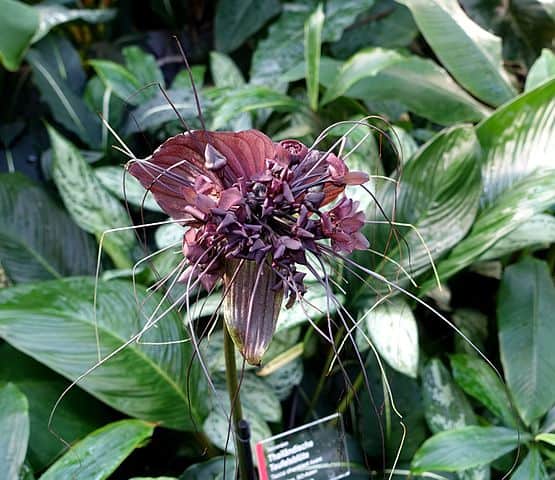
Venture into the shadowy, humid forests of Southeast Asia, and you may stumble upon the enigmatic Black Bat Flower (Tacca chantrieri). This captivating plant, with its dark, velvety blooms and long, trailing “whiskers,” evokes a sense of mystery and otherworldliness.
The Black Bat Flower’s unique appearance is an adaptation to its natural habitat, where it relies on specific pollinators, such as moths, to ensure its reproductive success. The plant’s dark coloration and intricate floral structure serve to attract these nocturnal visitors, who are drawn to the nectar-rich blooms.
Beyond its visual allure, the Black Bat Flower has also been the subject of numerous legends and folklore, with some cultures associating it with supernatural or mystical properties. This plant’s enigmatic nature continues to captivate and intrigue those who encounter it, reminding us of the boundless wonders that still exist in the natural world.
Lamb’s Ears (Stachys byzantina)
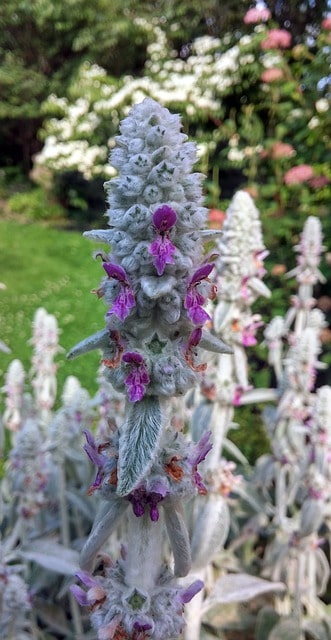
In the realm of unusual plants, the Lamb’s Ears (Stachys byzantina) stands out as a true botanical delight. With its soft, velvety leaves that resemble the fuzzy ears of a lamb, this perennial has become a beloved addition to gardens and landscapes around the world.
The Lamb’s Ears’ distinctive appearance is the result of its unique leaf structure, which features a dense covering of fine, silvery-gray hairs. This adaptation serves multiple purposes, including protecting the plant from excessive sun exposure, reducing water loss, and even deterring herbivores with its soft, fuzzy texture.
Beyond their visual appeal, Lamb’s Ears are also prized for their versatility and low-maintenance nature. These plants thrive in a variety of soil conditions and climates, making them an excellent choice for gardeners and landscapers alike. Additionally, the plant’s soft, wooly leaves have been used in traditional medicinal and culinary applications in some regions.
Dracunculus vulgaris (Black Arum)
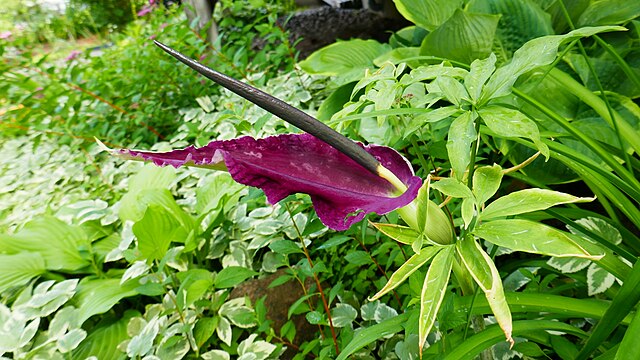
Another unusual plant is the Dracunculus vulgaris, more commonly known as the black arum or dragon arum. This perennial plant is native to the Mediterranean region and is known for its striking, almost alien-like appearance.
The most distinctive feature of the black arum is its large, dark purple-black flower spike, called a spadix, which can grow up to 3 feet tall. Surrounding the spadix is a large, deep purple-black petal-like structure called a spathe. Together, the spadix and spathe resemble a dragon’s head or a dark, gothic flower.
But the black arum’s unusual appearance serves an important purpose – it attracts pollinators. The dark color and unpleasant, rotting flesh-like odor of the flower mimics the scent of decaying matter, which attracts flies and other insects that feed on rotting organic material. These insects then inadvertently pollinate the plant as they crawl over the spadix.
After flowering, the black arum produces large, bright red berries that are mildly toxic to humans and pets. The plant goes dormant during the summer months, with the above-ground parts dying back, only to reemerge the following spring.
Despite its somewhat unsettling appearance, the black arum is a fascinating and unique addition to any garden or plant collection, especially for those interested in unusual or carnivorous plants.
Titan Arum (Corpse Flower)
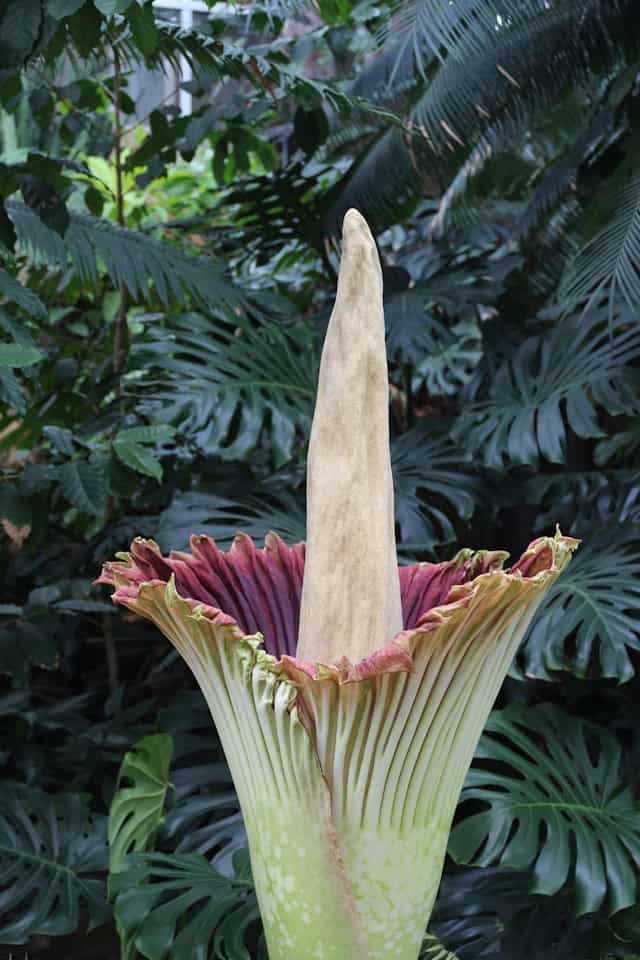
One of the most famous and bizarre-looking plants in the world is the titan arum, also known as the corpse flower. This massive, towering plant is native to the equatorial rainforests of Sumatra, Indonesia, and is renowned for producing the largest unbranched inflorescence (flower cluster) in the world.
The titan arum can grow up to 12 feet tall, with a single enormous leaf that can reach over 20 feet in diameter when fully unfurled. But the plant’s most remarkable feature is its massive, foul-smelling flower. When in bloom, the titan arum produces a gigantic, reddish-purple “flower” that can reach over 3 feet in diameter and weigh up to 200 pounds.
The putrid, rotting flesh-like odor of the titan arum’s flower is what earns it the nickname “corpse flower.” This stench, which has been described as a mix of decaying meat, dirty socks, and rotten eggs, is designed to attract the plant’s natural pollinators – carrion beetles and flesh flies. These insects are drawn to the flower, thinking it is a dead animal, and inadvertently spread the titan arum’s pollen as they crawl over the inflorescence.
Titan arums are extremely rare and difficult to grow, as they only bloom for 24-48 hours every 4-7 years. When they do bloom, it is a major event, with botanical gardens and conservatories around the world holding “corpse flower watches” to witness this incredible natural phenomenon. Seeing and smelling a titan arum in bloom is a truly unique and unforgettable experience.
Rafflesia
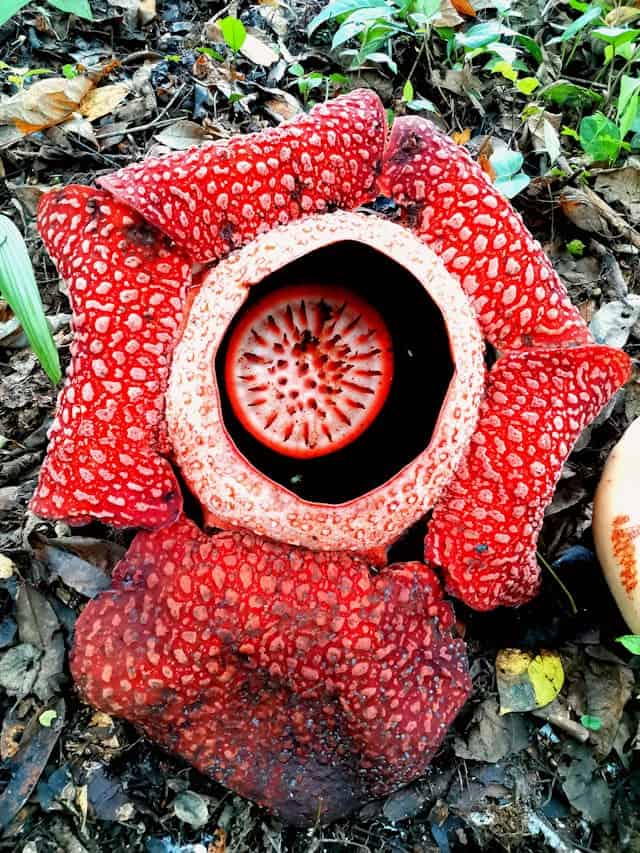
Another bizarre and fascinating plant is the Rafflesia, a genus of parasitic flowering plants native to the rainforests of Southeast Asia. Rafflesia plants have no true leaves, stems, or roots of their own. Instead, they are completely dependent on their host plants, growing within the tissues of vines in the genus Tetrastigma.
The most remarkable feature of Rafflesia is its massive, foul-smelling flower. The largest known species, Rafflesia arnoldii, can produce flowers up to 3 feet in diameter, making it one of the largest individual flowers in the world. The flower itself is a deep, mottled red color, with a texture that resembles rotting flesh. Like the titan arum, this unpleasant appearance and odor are adaptations to attract the plant’s pollinators – carrion flies and beetles.
Rafflesia flowers only bloom for 4-5 days before wilting and dying. During this brief window, the flower releases its powerful stench, which can be detected from miles away. After pollination, the plant develops fruit that eventually releases thousands of tiny seeds, which are dispersed by animals to find new host plants.
Due to their rarity and the difficulty of cultivating them, Rafflesia are considered endangered in many parts of their native range. Seeing a Rafflesia flower bloom in the wild is an incredibly rare and remarkable sight.
Tropical Pitcher Plants
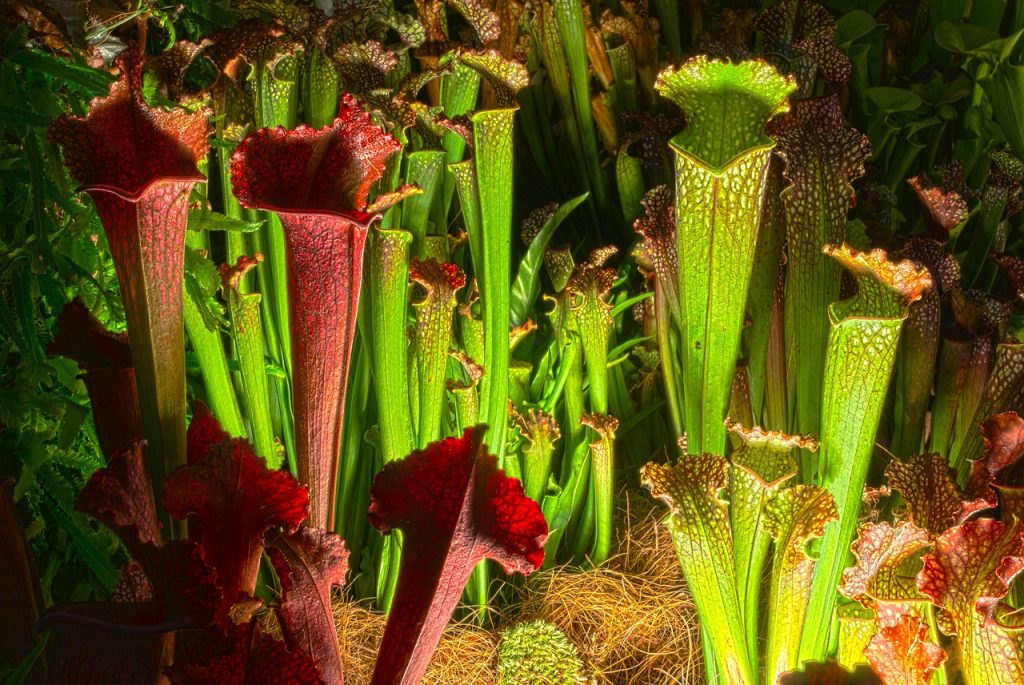
Pitcher plants are known for their unique, pitcher-shaped leaves that are adapted to trap and digest insects and other small prey.
The pitcher leaves of these plants are often brightly colored, with patterns and nectar glands that attract insects. Once an insect falls into the pitcher, it is unable to climb back out due to the slippery, waxy interior and downward-pointing hairs. The plant then secretes digestive enzymes to break down the prey, absorbing the nutrients.
Some of the most impressive tropical pitcher plants include the giant Nepenthes species, which can produce pitchers over 1 foot long. Other notable species include the beautifully patterned Nepenthes rajah, which can trap small rodents, and the bright red Nepenthes hamata.
Tropical pitcher plants make fascinating and unique houseplants, but they do require specific care and conditions to thrive, including high humidity, ample sunlight, and a constant supply of prey. With the right environment, these carnivorous wonders can be a stunning addition to any plant collection.
Cucamelons
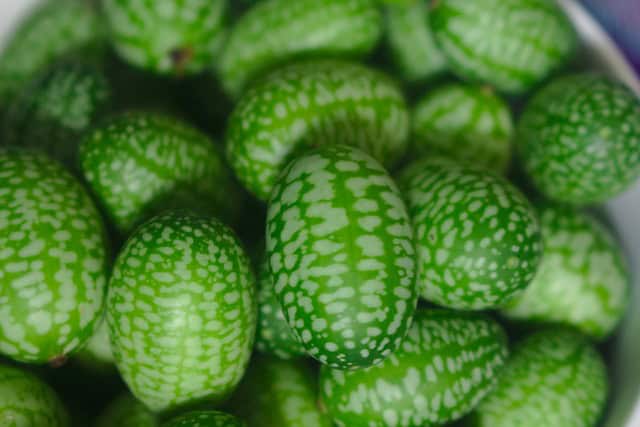
Cucamelons grow on a trailing vine and produce an abundance of tiny, oval-shaped fruits that are only about an inch long. These miniature “watermelons” have a bright green, striped exterior and a crisp, juicy flesh with a tangy, lemony flavor. They can be eaten whole, like tiny pickles, or used in salads, salsas, and other dishes.
What makes the cucamelon so unique is its appearance – the little fruits look just like tiny watermelons, complete with stripes. This distinctive look has earned them the nicknames “mouse melons” and “Mexican sour gherkins.” Cucamelons are also incredibly prolific, with a single plant capable of producing hundreds of the pint-sized fruits over the course of a growing season.
Despite their exotic appearance and flavor, cucamelons are actually quite easy to grow, making them a fun and unique addition to any vegetable garden. They thrive in hot, dry climates and can even be grown in containers. With their novel look and refreshing taste, cucamelons are sure to delight and surprise anyone who tries them.
Pineberries
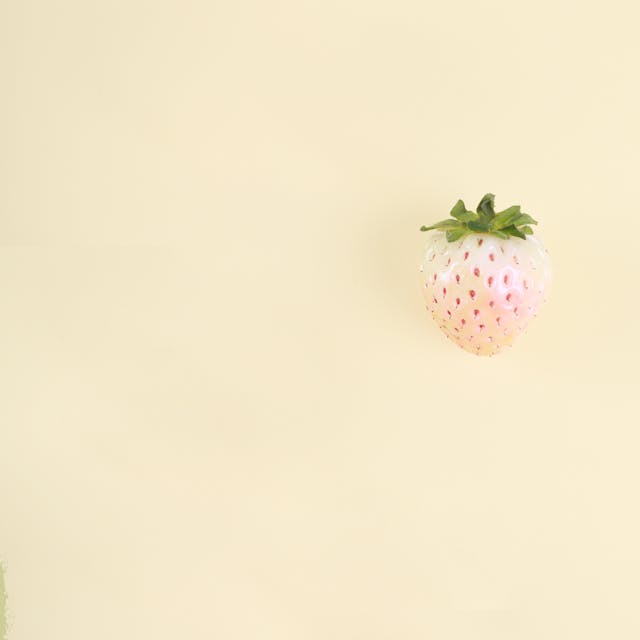
Another unusual edible plant is the pineberry, a rare and intriguing variety of strawberry. Pineberries look very similar to regular strawberries, but with one key difference – their color. Instead of the classic red hue, pineberries are white or pale pink in color, with red seeds dotting their surface.
But the pineberry’s unique appearance isn’t the only thing that sets it apart. These berries also have a distinctly different flavor profile compared to traditional strawberries. Pineberries taste like a combination of pineapple, strawberry, and vanilla, with a slightly tart and sweet taste. Some have even described the flavor as “tropical” or “citrusy.”
Pineberries are believed to be a natural hybrid of two wild strawberry species, and they were first rediscovered and cultivated in the Netherlands in the 1980s. Since then, they have gained a small but devoted following among adventurous foodies and home gardeners.
While pineberries can be more challenging to grow than standard strawberries, they make for a truly unique and eye-catching addition to any edible garden or fruit platter. Their novel appearance and tropical, pineapple-like flavor make them a fun and flavorful alternative to the classic red strawberry.
Desert Rose

Moving away from edible plants, another unusual and visually striking species is the desert rose, also known as the impala lily or adenium. This succulent plant is native to the arid regions of Africa and the Arabian Peninsula, and is prized for its distinctive, swollen trunk and showy, trumpet-shaped flowers.
The desert rose’s most notable feature is its thick, bulbous trunk, which can grow up to 3 feet wide. This trunk stores water, allowing the plant to survive long periods of drought. Emerging from the trunk are long, slender branches that are covered in dark green, leathery leaves.
But the real showstopper of the desert rose is its vibrant, pink or red flowers. These large, funnel-shaped blooms can reach up to 6 inches across and have a delicate, ruffled appearance. The flowers bloom in clusters at the tips of the branches, creating a stunning display.
Despite its exotic looks, the desert rose is actually quite easy to grow, making it a popular houseplant and landscaping plant in warm, dry climates. It requires full sun, infrequent watering, and well-draining soil to thrive. With its unique form and beautiful flowers, the desert rose is a truly one-of-a-kind addition to any plant collection.
Banana Shrub
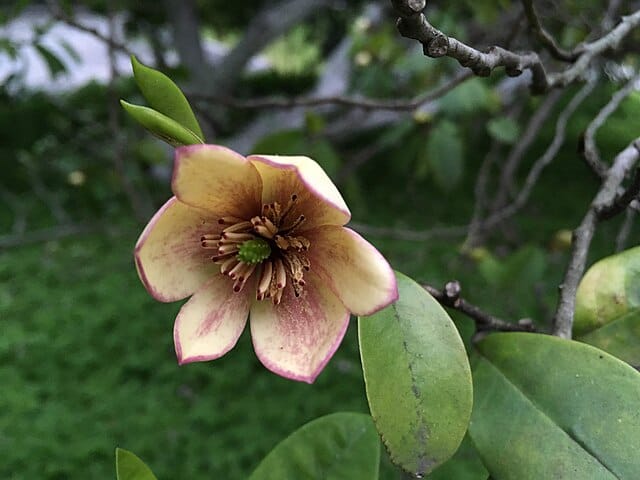
While most people are familiar with the towering, fruit-bearing banana tree, there is another, more unusual member of the banana family – the banana shrub. Also known as the Chinese banana or Michelia figo, this small, evergreen shrub is native to southern China and Vietnam.
Unlike its larger cousin, the banana shrub does not produce edible bananas. Instead, it is prized for its highly fragrant, banana-scented flowers. These small, creamy-white blooms have a distinctive, waxy texture and a sweet, banana-like aroma that can be detected from quite a distance.
The banana shrub’s flowers typically appear in clusters along the branches, blooming in the spring and early summer. After flowering, the plant produces small, olive-shaped fruits that are inedible to humans, but may be eaten by birds and other wildlife.
While the banana shrub does not grow as large as a true banana tree, it can still reach heights of 10-15 feet if left unpruned. It makes an excellent, compact specimen plant for gardens and patios, with its lush, glossy foliage and intoxicating floral scent. The banana shrub also thrives well in containers, making it a great option for those with limited outdoor space.
Overall, the banana shrub is a unique and delightful addition to any plant collection, especially for those who appreciate unusual, fragrant blooms. Its exotic appearance and captivating aroma are sure to delight the senses.
Climbing Sea Onion
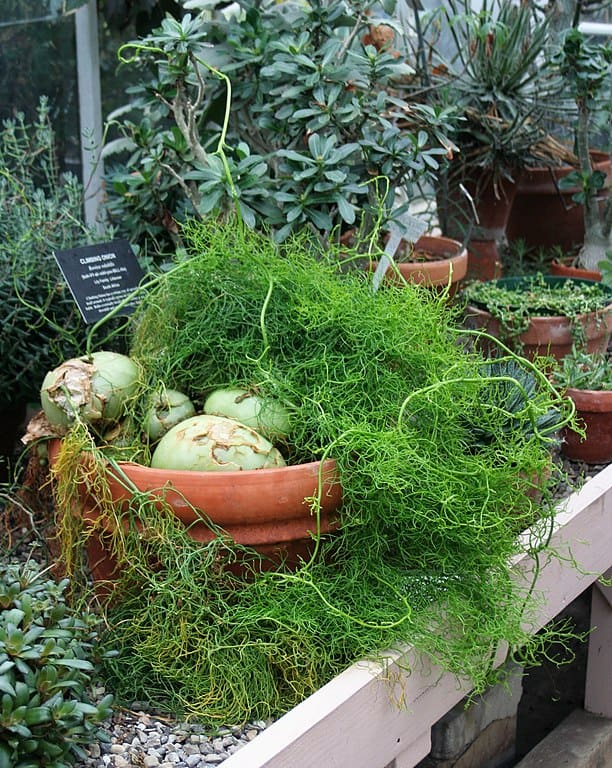
Another unusual plant is the climbing sea onion, also known as the sea onion vine or Bowiea volubilis. This succulent plant is native to southern Africa and is known for its bizarre, twisting vines and unusual growth habit.
The climbing sea onion does not actually resemble an onion at all. Instead, it produces a large, rounded, underground tuber that can grow up to 8 inches in diameter. From this tuber emerge long, slender, green vines that can reach up to 10 feet in length. These vines twist and twine as they grow, creating a visually striking, almost alien-like appearance.
The climbing sea onion’s vines are leafless, with the plant’s photosynthesis occurring in the green stems instead. Small, greenish-white flowers may occasionally appear at the tips of the vines, but the plant is primarily grown for its unique, sculptural form.
Due to its unusual growth habit, the climbing sea onion makes for a fascinating houseplant or outdoor container specimen. It thrives in hot, dry conditions and requires very little water, making it an ideal choice for those with a brown thumb. With its mesmerizing, twisting vines, the climbing sea onion is sure to be a conversation piece in any plant collection.
Club Moss
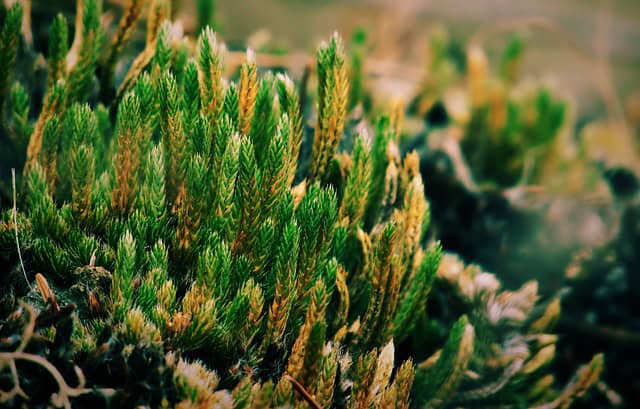
The final unusual plant we’ll explore is the club moss, a group of ancient, primitive plants that date back millions of years. Also known as ground pine or running cedar, club mosses are not actually true mosses, but rather a distinct group of vascular plants.
Club mosses are characterized by their low-growing, evergreen foliage and upright, club-shaped reproductive structures. The leaves of club mosses are small, scale-like, and densely packed along the stems, giving the plants a lush, carpet-like appearance. The “clubs” are the plant’s spore-bearing cones, which resemble tiny, upright pine cones.
While club mosses may look delicate, they are actually quite hardy and resilient. Many species are native to temperate and boreal forests, where they thrive in moist, shady conditions. Club mosses are also incredibly ancient, with some species dating back over 400 million years to the Devonian period.
Today, club mosses are prized by gardeners and plant enthusiasts for their unique, prehistoric look. They make excellent ground covers, accent plants, and terrarium specimens. Club mosses are also sometimes used in floral arrangements and holiday decorations, due to their long-lasting, evergreen foliage.
With their ancient lineage and distinctive appearance, club mosses are a truly unique and fascinating addition to any plant collection. They offer a glimpse into the distant past and a connection to the earliest forms of plant life on Earth.
Coffee Plant
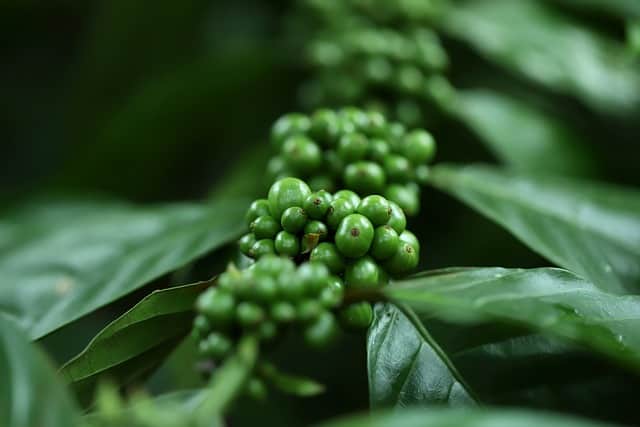
While most people are familiar with coffee as a beverage, the coffee plant itself is a rather unusual and fascinating specimen. The coffee plant, scientifically known as Coffea, is a genus of evergreen shrubs and trees native to tropical regions of Africa and Asia.
What makes the coffee plant so unique is its growth habit and appearance. Rather than a single, tall trunk, the coffee plant produces multiple, slender stems that grow upright, creating a bushy, multi-trunked form. The leaves are dark green, glossy, and elliptical in shape, growing in opposing pairs along the stems.
But the coffee plant’s most distinctive feature is its flowers and fruit. The plant produces small, fragrant white flowers that bloom in clusters. These flowers then develop into the familiar coffee “cherries” – small, red or purple berries that contain the coffee bean at their core.
Despite its tropical origins, the coffee plant can actually be grown as a houseplant in many climates, provided it receives ample sunlight and humidity. Dwarf or compact coffee varieties are especially well-suited for indoor cultivation. With its attractive foliage and the novelty of growing your own coffee beans, the coffee plant makes for a unique and rewarding addition to any plant collection.
Lifesaver Plant
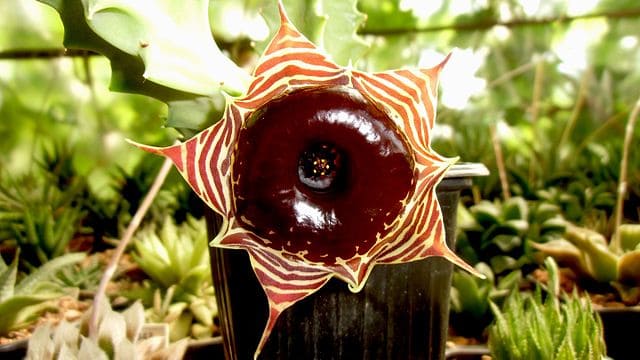
Another unusual plant is the lifesaver plant, also known as the hoya or wax plant. This genus of flowering vines and epiphytes is native to Southeast Asia and Australia, and is prized for its unique, waxy blooms.
The lifesaver plant gets its name from the distinctive shape of its flowers, which resemble miniature lifesavers or doughnuts. These blooms are typically pink, white, or red in color, and have a thick, waxy texture that gives them a glossy, almost artificial appearance. The flowers also produce a sweet, honey-like fragrance that attracts pollinators.
In addition to its unusual flowers, the lifesaver plant is also known for its trailing, vining growth habit. The plant produces long, slender stems that can climb or trail over surfaces, making it well-suited for hanging baskets, trellises, or shelves. The leaves are thick, leathery, and dark green, providing an attractive backdrop for the showy blooms.
While the lifesaver plant may look delicate, it is actually quite hardy and easy to care for. It thrives in bright, indirect light and well-draining soil, and only requires infrequent watering. With its unique flowers and trailing growth, the lifesaver plant is a captivating and low-maintenance addition to any indoor or outdoor plant collection.
Sensitive Plant

One of the most fascinating and unique plants in the world is the sensitive plant, also known as the sleepy plant or mimosa pudica. This small, herbaceous plant is native to Central and South America, and is known for its remarkable ability to respond to touch.
When the leaves or stems of the sensitive plant are gently touched or disturbed, the plant will quickly fold its leaves inward and droop downward. This rapid response is a defense mechanism that the plant uses to deter herbivores and protect itself from potential threats. The leaves will remain in this “sleeping” position for several minutes before slowly reopening and returning to their normal state.
The sensitive plant’s ability to move in response to stimuli is due to specialized cells within its leaves and stems that change shape and pressure when touched. This triggers a chain reaction that causes the leaves to fold inward and the stems to droop. It’s a truly remarkable adaptation that has captivated plant enthusiasts and scientists alike.
Beyond its unique movement, the sensitive plant is also visually striking, with delicate, fern-like foliage and small, pink or purple flowers. It grows as a low-growing, spreading plant, making it well-suited for containers, hanging baskets, or ground cover.
While the sensitive plant may seem fragile, it is actually quite hardy and easy to grow, provided it receives ample sunlight and moisture. With its mesmerizing response to touch and its attractive, lacy appearance, the sensitive plant is a truly one-of-a-kind addition to any plant collection.
California Pitcher Plant
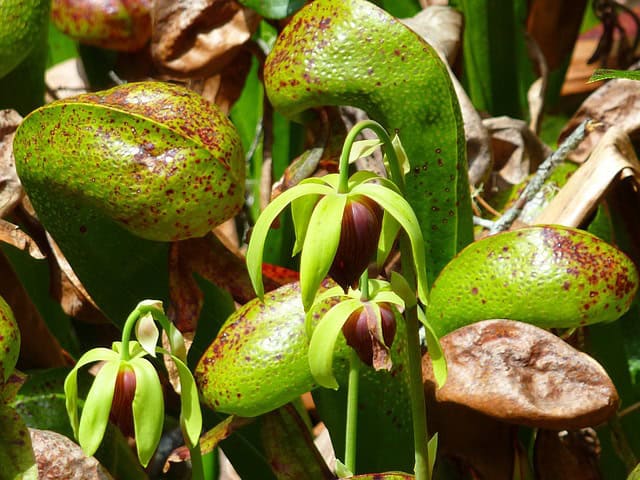
The next unusual plant we’ll explore is the California pitcher plant, also known as the cobra lily or cobra plant. This carnivorous plant is native to the wetlands and bogs of northern California and southern Oregon, and is known for its distinctive, pitcher-shaped leaves.
The California pitcher plant’s leaves are its primary means of trapping and digesting insects and other small prey. The leaves are shaped like elongated, trumpet-like pitchers, with a lid-like structure at the top that helps funnel insects into the plant’s digestive fluid-filled interior. Once an insect falls into the pitcher, it becomes trapped and is slowly dissolved by the plant’s enzymes, providing the California pitcher plant with essential nutrients.
In addition to its carnivorous leaves, the California pitcher plant also produces tall, slender flower stalks that can reach up to 3 feet in height. These stalks bear clusters of small, reddish-purple flowers that further contribute to the plant’s unique and captivating appearance.
While the California pitcher plant may seem delicate, it is actually quite hardy and can thrive in a variety of environments, provided it receives ample moisture and sunlight. It makes an excellent addition to bog gardens, terrariums, and other humid, wet settings.
For those fascinated by the natural world’s more unusual and specialized plant life, the California pitcher plant is a must-have. Its carnivorous nature and distinctive, pitcher-shaped leaves make it a truly one-of-a-kind addition to any plant collection.
Sundew
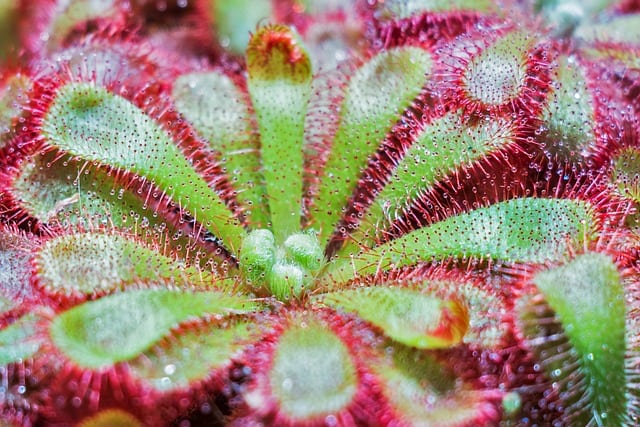
One of the most captivating and unusual carnivorous plants is the sundew. Belonging to the genus Drosera, sundews are found on every continent except Antarctica, with a particularly high diversity in Australia and other parts of the Southern Hemisphere.
What makes sundews so unique is their method of trapping and digesting prey. The leaves of sundews are covered in tiny, glandular tentacles that secrete a sticky, dew-like substance. When an insect or other small creature becomes trapped in this sticky “dew,” the tentacles will slowly curl around the prey, enveloping it. The plant then releases digestive enzymes to break down the trapped organism, absorbing the nutrients it provides.
The appearance of sundews is just as fascinating as their carnivorous behavior. The leaves are typically circular or spoon-shaped, with the sticky tentacles radiating outward like the petals of a flower. Many species also produce delicate, white or pink flowers that bloom atop tall stalks, adding to the plant’s otherworldly charm.
Sundews come in a wide variety of sizes, from the tiny, inch-tall Drosera capensis to the massive, 3-foot-wide Drosera gigantea. Regardless of their size, all sundews share a captivating, almost alien-like quality that has made them a favorite among carnivorous plant enthusiasts.
Caring for sundews can be a bit of a challenge, as they require very specific growing conditions – high humidity, plenty of sunlight, and nutrient-poor soil. However, for those willing to provide the right environment, sundews make for truly unique and rewarding additions to any plant collection.
Jewel Orchid
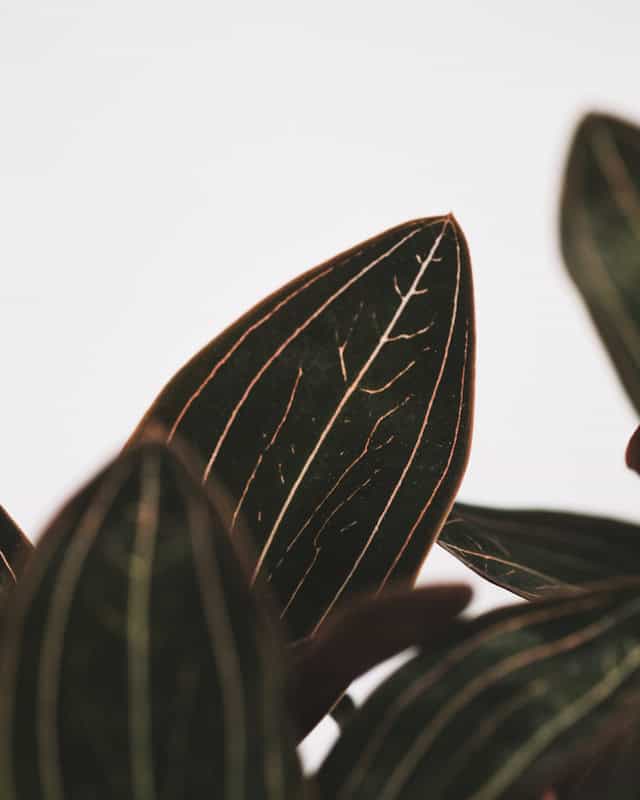
Another unusual and visually striking plant is the jewel orchid, a group of terrestrial orchids native to Southeast Asia. Jewel orchids are prized for their ornamental foliage, which often features intricate, metallic-colored patterns and textures.
The leaves of jewel orchids are the true stars of the show, with many species boasting stunning, vein-like patterns in shades of green, purple, red, and even metallic silver or gold. These patterns are created by the plant’s unique cellular structure, which refracts light in a way that produces the jewel-like effect. The leaves can also have a velvety or quilted texture, adding to their visual appeal.
While jewel orchids do produce small, inconspicuous flowers, it is their foliage that makes them such sought-after plants. Many species, such as Ludisia discolor and Macodes petola, are grown primarily for their ornamental leaves rather than their blooms.
Jewel orchids are relatively small, compact plants that thrive in humid, shaded environments. They make excellent houseplants, terrarium specimens, and accent plants in woodland-inspired gardens. With their mesmerizing, jewel-toned leaves, jewel orchids are a true feast for the eyes and a unique addition to any plant collection.
Venus Flytrap
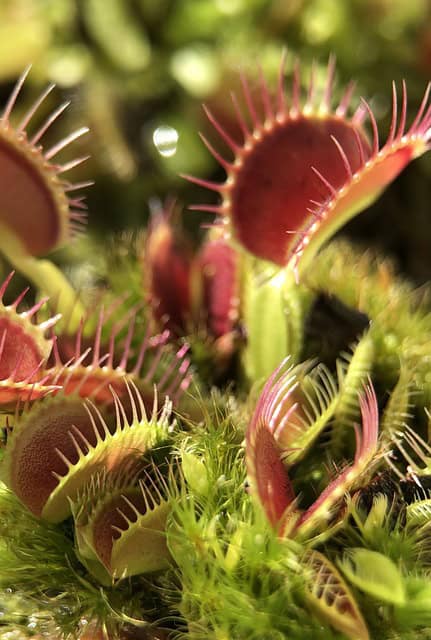
Perhaps the most well-known and iconic of all carnivorous plants is the Venus flytrap. Native to the wetlands of the Carolinas in the United States, the Venus flytrap is renowned for its remarkable ability to quickly trap and digest insects and other small prey.
The Venus flytrap’s trapping mechanism is truly remarkable. The plant’s leaves are divided into two distinct parts – a flat, open “trap” and a hinged, trigger-sensitive “jaw.” When an insect or other small creature touches the sensitive hairs inside the trap, the jaw snaps shut, trapping the prey inside. The plant then secretes digestive enzymes to break down the trapped organism, absorbing the nutrients it provides.
Once the prey has been fully digested, the trap will slowly reopen, ready to capture its next meal. This cycle can repeat several times before the trap needs to rest and regrow.
Beyond its carnivorous abilities, the Venus flytrap is also visually striking, with its deep green, spoon-shaped leaves and the bright red coloration of its traps. When the traps are open, they resemble small, gaping mouths, earning the plant its nickname of “the jaws of death.”
While the Venus flytrap may seem delicate, it is actually quite hardy and easy to grow, provided it receives the right growing conditions. It thrives in moist, nutrient-poor soil and bright, direct sunlight. With proper care, a healthy Venus flytrap can live for many years, continuing to captivate
Cooper’s Haworthia
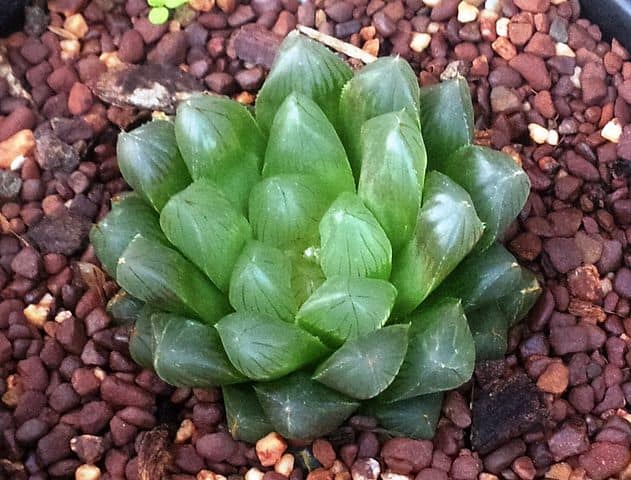
One of the most unique and visually striking succulents is the Cooper’s haworthia, also known as the zebra haworthia or zebra plant. This small, rosette-forming succulent is native to South Africa and is prized for its distinctive, striped foliage.
The leaves of the Cooper’s haworthia are thick, fleshy, and arranged in a tight, symmetrical rosette. What makes this plant so unusual is the intricate pattern of white, translucent stripes that run horizontally across the leaves. These stripes are created by windows, or transparent areas, in the leaves that allow light to pass through.
The overall effect is a mesmerizing, almost hypnotic appearance that has earned the Cooper’s haworthia its “zebra” moniker. The plant’s compact size and slow-growing nature also make it well-suited for growing in containers, terrariums, and other small-scale settings.
Beyond its striking appearance, the Cooper’s haworthia is also relatively easy to care for, requiring bright, indirect light and infrequent watering. It’s an excellent choice for succulent enthusiasts and plant collectors looking to add a unique and visually captivating specimen to their collection.
Living Stones
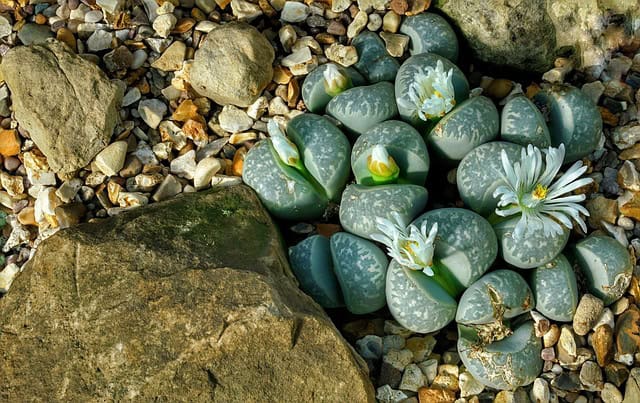
Another unusual and fascinating succulent is the living stone, also known as the lithops or “stone plant.” These diminutive succulents are native to southern Africa and are renowned for their uncanny resemblance to small, pebble-like stones.
The living stone’s most distinctive feature is its pair of fleshy, wedge-shaped leaves that are fused at the base, creating a flattened, almost cube-like appearance. The leaves are typically a mottled gray, brown, or green color, with intricate patterns and textures that mimic the look of real stones.
When the living stone is not in bloom, it is nearly impossible to distinguish from the surrounding rocks and pebbles in its natural habitat. This camouflage is an adaptation that helps the plant avoid detection by herbivores and other potential threats.
Despite their unassuming appearance, living stones are not only visually striking, but also quite fascinating to observe. The plants will periodically split open to reveal a small, daisy-like flower, adding a surprising burst of color to their otherwise drab exterior.
Caring for living stones can be a bit of a challenge, as they require very specific growing conditions, including bright, direct sunlight and extremely well-draining soil. However, for those willing to provide the right environment, these unique succulents make for a truly one-of-a-kind addition to any plant collection.
Pencil Cactus
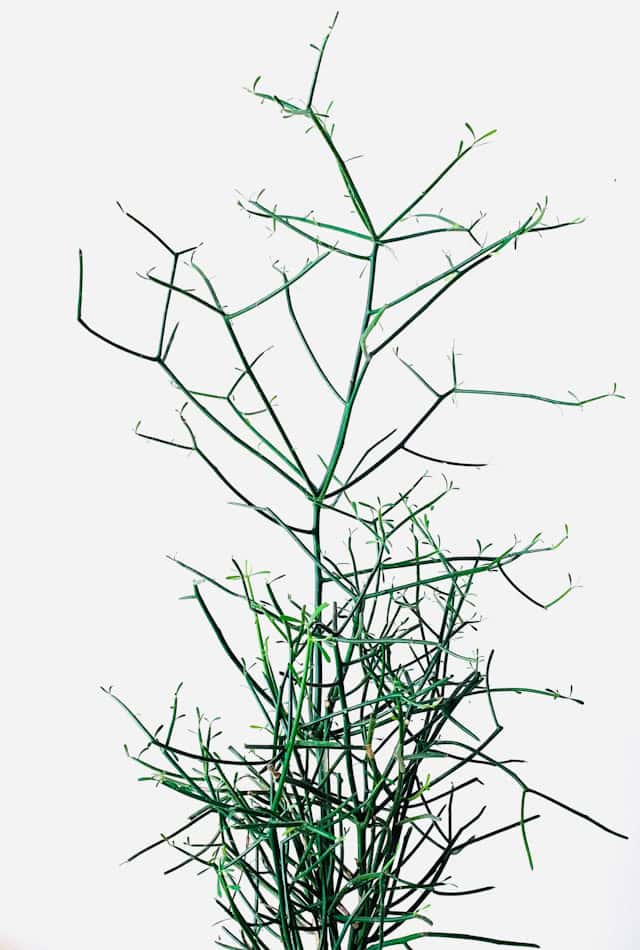
One of the most distinctive and eye-catching succulents in the plant world is the pencil cactus, also known as the sticks of fire or milk bush. This unique cactus species is native to parts of Africa and the Middle East, and is prized for its tall, slender, cylindrical stems that resemble oversized pencils.
The pencil cactus’ most striking feature is its vibrant, neon-green stems that can grow up to 6 feet tall. These stems are smooth, waxy, and virtually leafless, giving the plant a sleek, minimalist appearance. As the pencil cactus matures, the stems may develop a reddish or orange hue, adding even more visual interest.
While the pencil cactus may look delicate, it is actually quite hardy and drought-tolerant. In its natural habitat, the plant is adapted to survive in hot, arid environments with little rainfall. This makes it an excellent choice for xeriscaping, container gardening, and other low-maintenance settings.
One thing to keep in mind with the pencil cactus is that it produces a milky, latex-like sap that can be irritating to the skin. It’s important to handle this plant with care and avoid contact with the sap, which can cause skin irritation or allergic reactions in some individuals.
Despite this minor drawback, the pencil cactus remains a highly sought-after succulent for its unique, architectural appearance and low-maintenance care requirements. For those seeking a truly one-of-a-kind addition to their plant collection, the pencil cactus is a must-have.
Parachute Plant

Another unusual and captivating plant is the parachute plant, also known as the spider plant or airplane plant. This resilient, easy-to-grow houseplant is native to parts of Africa and is renowned for its cascading, spider-like foliage.
The parachute plant’s most distinctive feature is its long, slender leaves that dangle downward, creating a graceful, waterfall-like effect. These leaves are a vibrant, green color and have a slightly wavy or curled appearance, giving the plant a delicate, airy quality.
In addition to its striking foliage, the parachute plant also produces small, white flowers that bloom on long, arching stems. These flowers are followed by tiny, plantlet “pups” that dangle from the parent plant, resembling miniature parachutes. These pups can be easily propagated to create new plants, making the parachute plant a prolific and self-propagating houseplant.
Beyond its visual appeal, the parachute plant is also renowned for its air-purifying abilities, as it is capable of removing various toxins and pollutants from the air. This, combined with its low-maintenance care requirements, makes the parachute plant an excellent choice for both novice and experienced plant enthusiasts.
Whether grown in a hanging basket, on a shelf, or as a trailing accent in a larger planter, the parachute plant is a unique and captivating addition to any indoor space. Its cascading foliage and easy-going nature have made it a beloved houseplant for generations.
Corkscrew Albuca
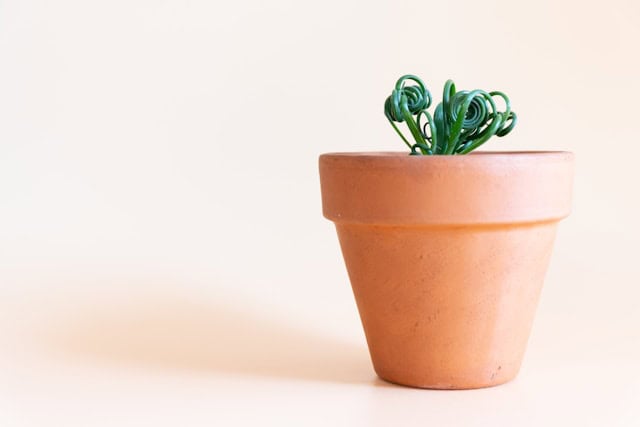
The final unusual plant we’ll explore is the corkscrew albuca, also known as the spiral albuca or serpent’s head. This unique member of the asparagus family is native to parts of Africa and is prized for its striking, corkscrew-shaped foliage.
The corkscrew albuca’s most distinctive feature is its long, slender leaves that twist and spiral upward, creating a mesmerizing, almost hypnotic appearance. These leaves can grow up to 2 feet in length and are a vibrant, emerald-green color, with a slightly waxy texture.
In addition to its unusual foliage, the corkscrew albuca also produces tall, slender flower stalks that bear clusters of small, greenish-white blooms. These flowers add an extra layer of visual interest to the plant, complementing the striking, spiral leaves.
While the corkscrew albuca may look delicate, it is actually quite hardy and easy to grow, provided it receives the right growing conditions. It thrives in well-draining soil and bright, indirect light, making it a suitable choice for both indoor and outdoor settings.


